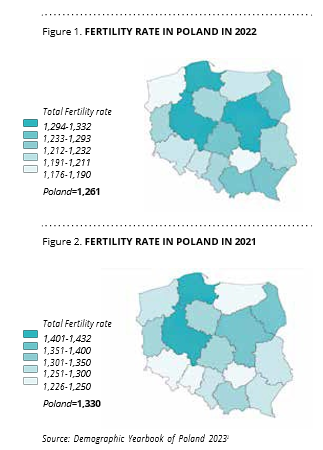This article was published in Vol. 4 No. 2 of our print edition.
One of the most pressing challenges confronting modern developed countries revolves around the interconnected web of social and familial crises, which collectively contribute to a significant and alarming decline in fertility rates. The intricate tapestry of many contemporary societies is increasingly marked by the fragility of family structures and the erosion of traditional systems, leading to a profound social crisis that reverberates across various facets of these nations. The family crisis, a key element in this broader social dilemma, manifests in multifaceted ways. Rapid societal changes, shifting cultural norms, and the relentless pursuit of individual egoistic aspirations have collectively contributed to the unravelling of the familial fabric that once served as a stabilizing force.
Traditional values and intergenerational connections, once a bedrock of stability, find themselves increasingly strained by the demands of a fast-paced, globalized world. As familial structures weaken, a palpable consequence emerges in the form of a startlingly low fertility rate, which represents a stark demographic challenge. The decision to delay or forgo childbearing becomes a complex interplay of economic uncertainties, career aspirations, and the struggle to balance work–life dynamics. The resulting decline in the number of births not only poses immediate economic challenges, but also sets the stage for long-term demographic imbalances, leading to an ageing population, a shrinking workforce, and a family crisis. Poland is no exception here. Despite two terms of the Law and Justice Party (PiS) government implementing pro-family policies, it appears inevitable that Poland will soon experience a steep demographic decline.
The concerning demographic condition in Poland is affirmed by the most recent report from Statistics Poland (GUS). Over the past few years, the country has grappled with negative natural growth, signifying that in a given year, more deaths than births occur (in 2022, the deficit was 143,000 people).1 The figure below illustrates how the fertility rate in Poland plunged dramatically from 1.330 in 2021 to a mere 1.26 in 2022. This precipitous decline is not only alarming, but also indicative of a remarkably rapid deterioration in the nation’s fertility levels. The figures underscore the urgency of addressing the factors contributing to this decline and implementing effective measures to reverse the trend. Understanding and mitigating these challenges are imperative for ensuring the long-term demographic health and sustainability of the country.
Contemplating the critical decline in fertility rates prompts us to reflect on the effectiveness of the family-friendly policies that have been implemented thus far. Have the measures undertaken to support families and encourage childbearing yielded the desired results?
Over the course of its two terms in office, the Law and Justice government consistently prioritized pro-family policies, designating them as a cornerstone of its governance agenda. Numerous programmes introduced during its time in power were flagship initiatives of the government, reflecting a concerted effort to address demographic challenges and reinforce family values within a broader societal framework. The commitment to pro-family policies underscores a recognition of the pivotal role that family stability plays in shaping the overall wellbeing of a nation. These initiatives encompassed a spectrum of measures, including financial incentives, parental leave policies, and support programmes aimed at easing the economic and social burdens on families. The intention was clear: to create an environment conducive to family growth and the flourishing of stable, supportive family structures.

In a significant move, in 2021 the Law and Justice government launched its Demographic Strategy 2040, marking a pioneering effort as the first document of its kind in Poland. This strategic initiative stands out as an acknowledgment of the pivotal role demographic challenges play in shaping the nation’s future. Strikingly, no previous government had directly confronted this issue, despite the undeniable fact that demography stands as one of the foremost challenges facing Polish society in the decades to come. Demographic Strategy 2040 underscores a forward-thinking approach aimed at extricating the nation from the low fertility trap that has become increasingly evident in recent years. Recognizing the imperative to secure the replacement of generations, the strategy outlines a comprehensive roadmap to address the complex interplay of factors contributing to declining fertility rates. By charting a course towards a more sustainable demographic future, the former government sought to create conditions that encourage family growth and provide the necessary support structures for individuals contemplating parenthood.3
The Law and Justice government spearheaded a series of flagship programmes aimed at bolstering family welfare and societal participation. One such initiative is ‘Family 500 plus’, later extended to ‘800 plus’, which provided a monthly subsidy of 500 Polish złoty for each child after the firstborn, up to the age of eighteen, regardless of family income. Notably, this has since been modified to encompass also the first child in a family. Another noteworthy program is the ‘Zero PIT for young people’, offering tax relief for individuals up to the age of 26, impacting around two million Poles. The ‘Good Start’ initiative allocates 300 złoty to parents for purchasing school starter kits for children up to the age of 20 (24 for children with disabilities). The ‘Large Family Card’ extends discounts to families with at least three children as dependants, fostering societal inclusion. The ‘Mama 4+’ programme, introduced in 2019, supports individuals raising at least four children who face financial constraints. ‘Pension plus’, implemented in 2019, ensures the automatic payment of a 13th monthly pension every year, alleviating financial burdens for seniors. Furthermore, the ‘500 plus for seniors’, initiated in 2019, grants a 500 złoty allowance to individuals incapable of independent living, with specific conditions placed on the total assistance received.
These comprehensive programmes collectively reflect the former government’s commitment to addressing diverse demographic and socio-economic challenges, contributing to a multifaceted approach to societal wellbeing. However, despite the implementation of these various financial incentives and comprehensive policies aimed at supporting families, the birth rate in Poland has, regrettably, shown no notable increase. The multifaceted nature of the demographic challenge, influenced by a myriad of societal, economic, and cultural factors, underscores the complexity of reversing the downward trend in birth rates.
‘By initiating crucial policy frameworks and achieving tangible successes in alleviating child poverty, the government set a precedent for future administrations’
In contrast to the challenges faced in increasing the birth rate, the policies implemented in Poland have had a remarkable impact on reducing child poverty. Before the launch of the Family 500+ programme in 2015, child poverty in Poland was disproportionately higher than poverty across the general population, standing at close to 14 per cent for children compared to 10 per cent overall. The introduction of the Family 500+ benefit sparked a transformative change, leading to a substantial reduction in child poverty. Within just two years of the programme’s launch, child poverty plummeted by an impressive 50 per cent, dropping below 7 per cent. Although there was a slight subsequent increase, child poverty consistently remained below the overall poverty level. This achievement underscores the effectiveness of targeted financial support in ameliorating the economic conditions of families with children, highlighting the success of the policies in directly addressing and mitigating child poverty.4 The Family 500+ programme, along with other family-friendly initiatives, has played a pivotal role in elevating the economic wellbeing of families, particularly those with children. By providing financial assistance and support, these policies have succeeded in substantially reducing child poverty rates, marking a significant positive outcome in the broader context of societal welfare.
While the policies introduced by the Law and Justice government may have faced challenges in achieving certain demographic goals, it is nevertheless essential to recognize the unprecedented steps taken by that government in tackling this issue. The Law and Justice administration became the first in Poland to proactively address the complex issue of demographic decline by formulating the groundbreaking Demographic Strategy 2040. This strategic initiative reflects a commitment to tackling the root causes of demographic challenges and creating a comprehensive framework for a sustainable future. In essence, the Law and Justice government, despite facing complexities and uncertainties, has left an indelible mark as a trailblazer in addressing demographic challenges and prioritizing societal welfare. By initiating crucial policy frameworks and achieving tangible successes in alleviating child poverty, the government set a precedent for future administrations to consider holistic strategies that would extend beyond immediate demographic calculation, fostering instead a resilient and inclusive society for generations to come.
NOTES
1 Anna Cieślak-Wróblewska, ‘Katastrofa demograficzna w Polsce już się zaczęła’, Rzeczpospolita (12 October 2023).
2 Demograficzny, R. Główny Urząd Statystyczny (Statistics Poland), Warszawa (2023) (Demographic Yearbook of Poland).
3 Strategia Demograficzna 2040 (Demographic Strategy 2040), Serwis Rzeczypospolitej Polskiej (2021), www.gov.pl/web/demografia/ruszaja-konsultacje-spoleczne-strategii-demograficznej-2040, accessed 20 January 2024.
4 Cook, L. J., Iarskaia-Smirnova, E. R., and Kozlov, V. A., ‘Trying to Reverse Demographic Decline: Pro-Natalist and Family Policies in Russia, Poland and Hungary’, Social Policy and Society, 22/2 (2023), 355–375, 363.







